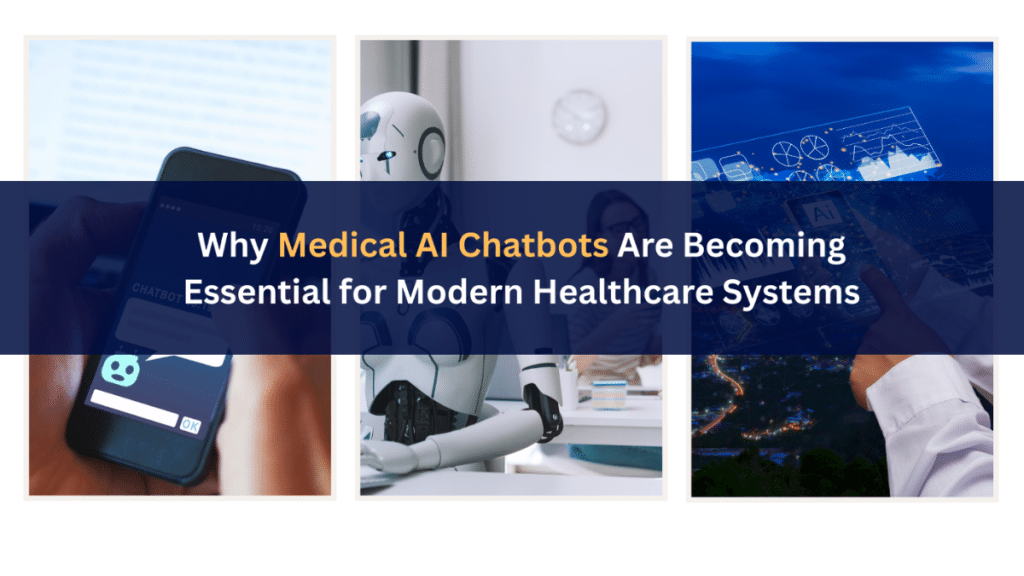Introduction – A New Era in Healthcare Support
Picture this: a worried parent logs onto their clinic’s website at midnight because their child has a sudden rash. Within seconds, a friendly digital assistant pops up, asks a few simple questions, and guides them on whether to seek urgent care or book an appointment for the morning. No waiting on hold, no frantic web searches—just fast, clear guidance.
That’s the kind of thing medical AI chatbots are quietly doing every day. Not shouting about it, just… doing it. They’re booking appointments, pulling patient details, giving doctors summaries so no one’s starting from scratch. Chatbots in the healthcare industry aren’t here to swap out doctors or nurses—they’re here to plug the gaps, handle the quick stuff, and make sure people don’t spend hours chasing answers.
Streamlining Administration with Healthcare Chatbots
Interesting stat: More than 350 healthcare groups found AI could save over 15,000 admin hours a month, cut paperwork time nearly in half, and still hit 99.5% accuracy (athenahealth.com).
Anyone who’s worked in a clinic knows the drill—calls for appointments, reschedules, insurance forms, reminder calls. It’s constant. A healthcare chatbot takes a big slice of that off the team’s plate. Patients can log in, book in minutes, get a reminder ping, even send a refill request. No hold music, no phone tag.
Some setups run almost like an AI medical assistant for staff. They’ll double-check patient info, ping polite payment reminders, collect visit feedback. It sounds small until you add it up across hundreds of patients. A chatbot in the healthcare industry isn’t just answering questions—it’s digging out the backlog so people can actually breathe.
Supporting Doctors with Conversational AI for Healthcare
Interesting stat: In one 30-day trial, an AI assistant cut visit prep time by 61%, boosted diagnoses by 25%, and lowered burnout scores for doctors (medicaleconomics.com).
That’s a lot. A doctor who needed 14 minutes to prep is suddenly ready in 5 or 6. That’s more time talking to people instead of staring at a screen. This is hipaa compliant telehealth Software in action—summarizing charts, flagging vitals, finding old notes without the hunt.
And it’s not just about minutes saved. In that trial, doctors felt more prepared, found more diagnoses, and went home less fried. That’s not a “nice-to-have” benefit—it’s the kind of change that keeps people in the job.
Enhancing Patient Engagement and Access to Care
Interesting stat: Some clinics using conversational AI reminders have cut missed appointments by up to 34%(mckinsey.com).
That’s no small thing. A healthcare AI chatbot can send the nudge someone needs—a reminder, a check-in, a quick explainer. For someone miles from the clinic or working back-to-back shifts, that’s real access. A medical AI chatbot means no waiting weeks just to ask a simple question.
Plus, fast, useful answers do something important—they make people feel looked after. That trust sticks, and it keeps them showing up for care instead of slipping through the cracks.
Conclusion – A Tool That’s Here to Stay
Medical AI chatbots have moved past the “cool new tech” stage. They save time, ease workloads, and keep patients in the loop.
Something like the AI Chatbot Assistant shows how this works best—let the AI handle the repetitive stuff, spot what’s urgent, and leave the rest to human hands. In the chatbot in the healthcare industry world, that’s the sweet spot—better care, better access, and a smoother ride for everyone.
Angela Spearman is a journalist at EzineMark who enjoys writing about the latest trending technology and business news.
